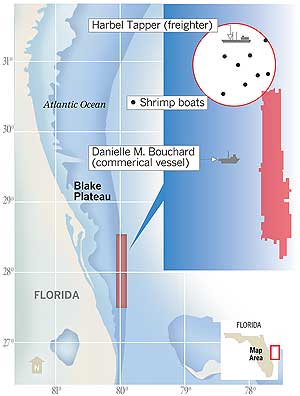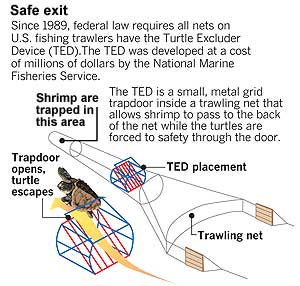|

The Oculina coral reefs are a rare and wondrous
natural treasure, just 25 miles east of Daytona Beach. Up to 300
feet deep on the Atlantic Ocean floor, the delicate coral seems
worlds away. But, they weren't far enough away to prevent widescale
destruction by unchecked fishing practices in the 1970s and '80s.
And now, even though miles have been protected, the Oculina's
destiny is still unknown. Roll your mouse over
the images for more details.
What's the water quality on our beaches?
 Environmental specialists with local health
departments wade into the sea once a week collecting samples to
answer that question. Local water quality benefits from wide beaches
and strong currents, said Chip Schelble, who oversees the program in
Volusia County. The samples are tested for bacteria that can cause
stomach illness and indicate other, more hazardous bacteria. If
bacteria counts are high, a swimming advisory is issued. Flagler
County has never issued an advisory in six years of monitoring. But
itıs happened six times in the past two years on Volusia beaches,
usually in the spring and winter, which Schelble attributes to the
droppings of large flocks of migrating birds.Workers have tested the
water after huge storms, he said, and did not find high bacteria
levels. Environmental specialists with local health
departments wade into the sea once a week collecting samples to
answer that question. Local water quality benefits from wide beaches
and strong currents, said Chip Schelble, who oversees the program in
Volusia County. The samples are tested for bacteria that can cause
stomach illness and indicate other, more hazardous bacteria. If
bacteria counts are high, a swimming advisory is issued. Flagler
County has never issued an advisory in six years of monitoring. But
itıs happened six times in the past two years on Volusia beaches,
usually in the spring and winter, which Schelble attributes to the
droppings of large flocks of migrating birds.Workers have tested the
water after huge storms, he said, and did not find high bacteria
levels.
|
Eat more fish... maybe not
A spiraling
demand for seafood worldwide, aided by high-tech advances in
the fishing industry, sent the populations of many marine life
species plummeting. The worldıs seafood consumption nearly
tripled in 25 years between 1950 and 1975 and has fluctuated
since then. Shown below is the weight of seafood caught in the
Atlantic Ocean between 1950 and 2004 in 1,000 tons.


-- A typical shrimp trawler is 90 plus feet
long, 700 to 1,000 horsepower
-- Itıs pulling four 60-foot
nets 12-feet wide, with 42-inch tall doors.
--The
combination of the gear is about 3,500 pounds on each
side.
|
|
Where the Oculina is and what's out
there
In a busy ocean, marine life and vessels
compete for space. At one time on a clear day in August, all
of these boats were spotted on the radars of the Coast Guard
cutter Shrike, just a mile outside the borders of a protected
area of the Oculina Bank. A pod of 18 to 20 Atlantic spotted
dolphins and two sea turtles also were seen.


|
SOURCES: Florida Fish and Wildlife Conservation Commission, Food and
Agriculture Organization of the United Nations, Harbor Branch
Oceanographic Institution, National Oceanic and Atmospheric
Administration, New England Aquarium, Reef Ball Foundation and
News-Journal research.
News-Journal / SCOTT HIESTAND
| 








